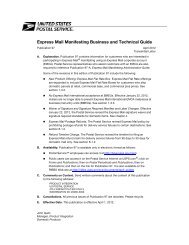2010 Comprehensive Statement on Postal Operations - USPS.com
2010 Comprehensive Statement on Postal Operations - USPS.com
2010 Comprehensive Statement on Postal Operations - USPS.com
Create successful ePaper yourself
Turn your PDF publications into a flip-book with our unique Google optimized e-Paper software.
Chapter 3: Operati<strong>on</strong>s<br />
Standardizati<strong>on</strong> and Network<br />
Optimizati<strong>on</strong><br />
Lean Six Sigma<br />
Standardizati<strong>on</strong> c<strong>on</strong>tinues to play a major role in improving service<br />
and efficiency in all operati<strong>on</strong>s and support activities. Lean Six<br />
Sigma (LSS) tools such as value stream mapping are used to<br />
simplify and standardize processes. Best practices are documented<br />
and shared throughout the organizati<strong>on</strong> to create a culture of<br />
c<strong>on</strong>tinuous improvement. Lean management efforts target process<br />
variability and help identify n<strong>on</strong>-value activities. Over 800 c<strong>on</strong>tinuous<br />
improvement initiatives have been identified in mail acceptance,<br />
operati<strong>on</strong>s, transportati<strong>on</strong>, and service improvement.<br />
New field operati<strong>on</strong> industrial engineers are playing an important<br />
role in the expansi<strong>on</strong> of c<strong>on</strong>tinuous improvement. An additi<strong>on</strong>al<br />
2,200 employees have <strong>com</strong>pleted LSS training, with 450 earning<br />
certificati<strong>on</strong> as LSS Executive, Green Belt, or Black Belt by leading<br />
key initiatives.<br />
Earlier this year, the <strong>Postal</strong> Service received two awards at the<br />
Internati<strong>on</strong>al Quality and Productivity Center Lean Six Sigma Summit.<br />
As part of its <strong>com</strong>mitment, the organizati<strong>on</strong> is providing training at<br />
all management levels to foster an envir<strong>on</strong>ment where data-driven<br />
decisi<strong>on</strong>s lead to improved performance, positive financial gains, and<br />
improved teamwork and employee <strong>com</strong>mitment.<br />
Resource Optimizati<strong>on</strong><br />
COMPLEMENT MANAGEMENT<br />
Managers c<strong>on</strong>tinue to improve their use of data to better align<br />
staffing with changing workload. There were 583,908 career<br />
employees at the end of <str<strong>on</strong>g>2010</str<strong>on</strong>g>, which is 39,220 fewer than last year.<br />
There were also 87,779 n<strong>on</strong>career employees. Reducti<strong>on</strong>s occurred<br />
in bargaining and n<strong>on</strong>bargaining categories and managers c<strong>on</strong>tinue<br />
to plan for steady employee attriti<strong>on</strong> by repositi<strong>on</strong>ing employees<br />
based <strong>on</strong> current and future resource requirements.<br />
Approximately 75 milli<strong>on</strong> work hours were saved in <str<strong>on</strong>g>2010</str<strong>on</strong>g>. This is in<br />
additi<strong>on</strong> to 115 milli<strong>on</strong> hours reduced the previous year, 50 milli<strong>on</strong><br />
hours in 2008, and 36 milli<strong>on</strong> hours in 2007. Over four years, the<br />
<strong>Postal</strong> Service achieved a total reducti<strong>on</strong> of 276 milli<strong>on</strong> work hours,<br />
the equivalent of 157,000 full-time employees.<br />
In customer service operati<strong>on</strong>s, scheduling improvements were<br />
the lead factor in saving 18 milli<strong>on</strong> work hours. In city delivery,<br />
1,108 routes were eliminated, in additi<strong>on</strong> to pivoting open routes<br />
and managing work hour variances, which c<strong>on</strong>tributed to savings of<br />
16 milli<strong>on</strong> work hours. The number of delivery vehicles and related<br />
support costs were also reduced.<br />
Mail Volume and Work Hour Reducti<strong>on</strong>s Change from 2009<br />
-10.6%<br />
-10.1%<br />
-6.1%<br />
-6.0%<br />
-3.5%<br />
-3.8%<br />
-2.2%<br />
-0.6%<br />
-12% -10% -8% -6% -4% -2% 0%<br />
Mail Volume<br />
Mail Processing<br />
Customer Services<br />
City Delivery<br />
Rural Delivery<br />
Postmasters<br />
Other<br />
Average all Functi<strong>on</strong>s<br />
NETWORK OPTIMIZATION<br />
The <strong>Postal</strong> Service c<strong>on</strong>tinuously m<strong>on</strong>itors and adapts its processing<br />
and transportati<strong>on</strong> networks to changing customer mailing patterns<br />
and mail volume fluctuati<strong>on</strong>s. For example, the volume of stamped<br />
Single-Piece First-Class Mail, which requires a high degree of<br />
processing, declined. In the same period, presorted First-Class<br />
Mail volumes decreased 3.8 percent. Ongoing adjustments to such<br />
changes are essential to maintaining optimal performance.<br />
In December 2009, the <strong>Postal</strong> Service provided C<strong>on</strong>gress with an<br />
annual update of the Network Plan, as required by the <strong>Postal</strong> Act.<br />
The plan highlighted three integrated elements of the optimizati<strong>on</strong><br />
effort: closure of airport mail centers (AMCs), c<strong>on</strong>solidati<strong>on</strong> of<br />
redundant mail processing operati<strong>on</strong>, and transformati<strong>on</strong> of the bulk<br />
mail center (BMC) network. Two of the three efforts were <strong>com</strong>pleted<br />
in <str<strong>on</strong>g>2010</str<strong>on</strong>g> and the third — c<strong>on</strong>solidati<strong>on</strong> of redundant mail processing<br />
operati<strong>on</strong>s — is an <strong>on</strong>going effort.<br />
The last AMC was closed in <str<strong>on</strong>g>2010</str<strong>on</strong>g>, with operati<strong>on</strong>s relocated to<br />
other facilities. The other 12 AMC locati<strong>on</strong>s were reclassified<br />
as processing centers or customer/retail units. AMC closures<br />
reflect the shift of more mail from air to surface transportati<strong>on</strong>,<br />
which can substantially reduce costs without <strong>com</strong>promising<br />
service performance.<br />
C<strong>on</strong>solidati<strong>on</strong> of outgoing and/or in<strong>com</strong>ing processing operati<strong>on</strong>s<br />
is c<strong>on</strong>sidered when service objectives can be met and operati<strong>on</strong>al<br />
efficiency improved. Following Area Mail Processing (AMP)<br />
guidelines, 37 new AMP feasibility studies were initiated this year,<br />
and 35 AMP c<strong>on</strong>solidati<strong>on</strong>s were implemented for total savings of<br />
over $99 milli<strong>on</strong>.<br />
Transformati<strong>on</strong> of BMCs into network distributi<strong>on</strong> centers (NDCs)<br />
was <strong>com</strong>pleted in <str<strong>on</strong>g>2010</str<strong>on</strong>g>. The transiti<strong>on</strong> to the rec<strong>on</strong>figured NDCs is<br />
an excellent illustrati<strong>on</strong> of the potential of c<strong>on</strong>solidating networks.<br />
NDCs process surface mail at fewer facilities and optimize ground<br />
transportati<strong>on</strong>. In additi<strong>on</strong> to producing service gains, especially for<br />
Periodicals, the changes reduce costs by improving mail preparati<strong>on</strong>,<br />
<str<strong>on</strong>g>2010</str<strong>on</strong>g> <str<strong>on</strong>g>Comprehensive</str<strong>on</strong>g> <str<strong>on</strong>g>Statement</str<strong>on</strong>g> <strong>on</strong> <strong>Postal</strong> Operati<strong>on</strong>s | 19

















